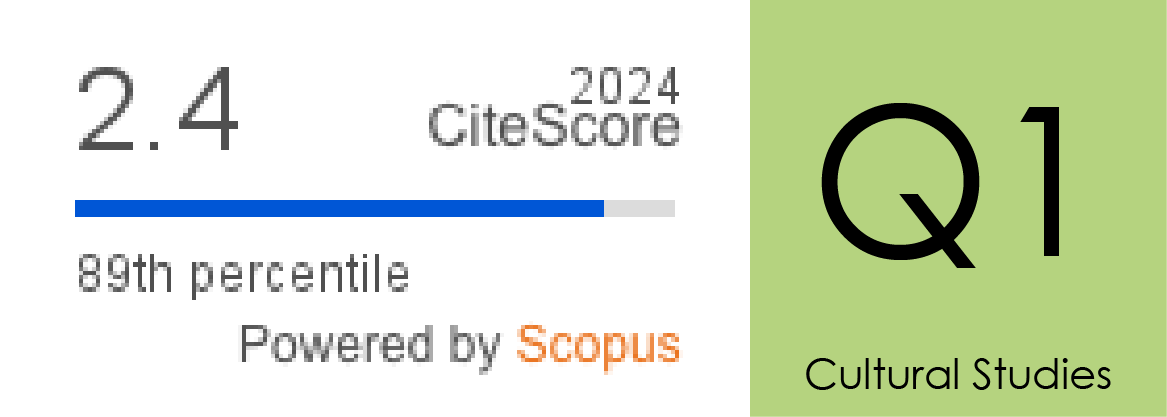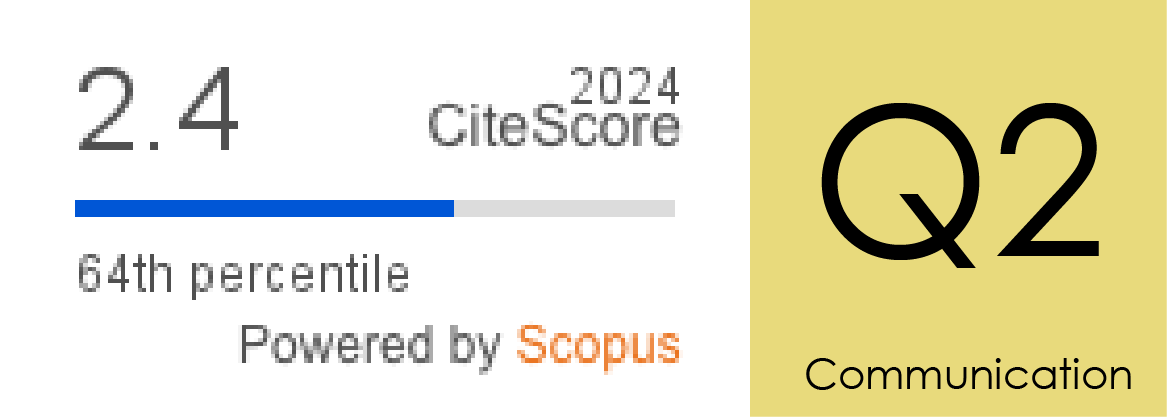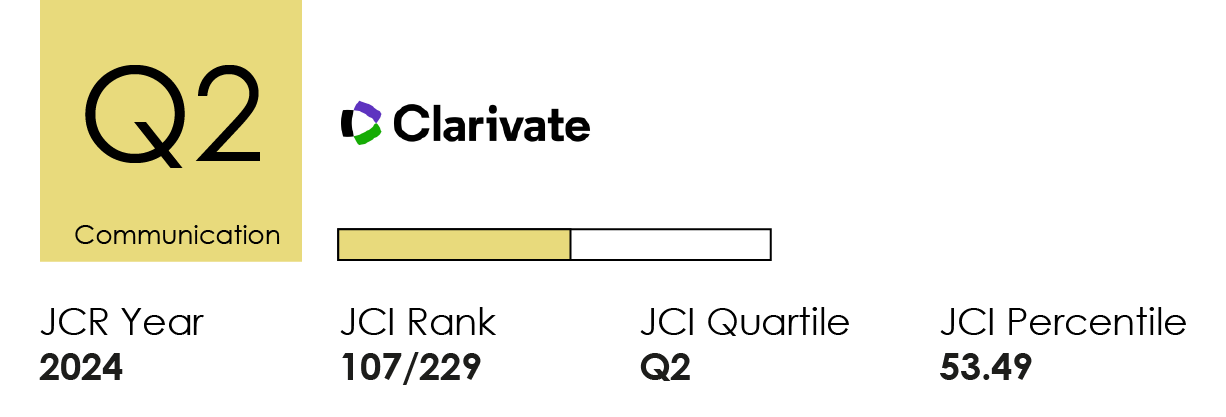Espiral del silencio 2.0: dinámicas de autocensura y participación en redes sociales y WhatsApp
DOI:
https://doi.org/10.14198/MEDCOM.30256Palabras clave:
Autocensura , Espiral del silencio, miedo al aislamiento, opinión pública, redes sociales, WhatsAppResumen
Propósito. Este estudio analiza la vigencia de la
teoría de la espiral del silencio en redes sociales y
WhatsApp, evaluando si el miedo al aislamiento
y la voluntad de hablar influyen en la expresión
de opiniones en entornos digitales. Metodología.
Se aplicó una encuesta a 1.350 personas de
la Comunidad de Madrid. Se usaron análisis
descriptivos, Chi-cuadrado, regresión logística
binaria y análisis factorial para identificar perfiles de
comportamiento ante temas polémicos en redes.
Resultados y conclusiones. La espiral del silencio
persiste en el entorno digital. Se identificaron cuatro
perfiles: silenciosos, temerosos, determinados y
polémicos. La edad, el nivel educativo y la clase
social influyen en la participación: los jóvenes y
personas de clase alta son más activos, mientras
que los mayores y con menor formación tienden al
silencio. WhatsApp se comporta como un espacio
ambivalente, donde la cercanía entre usuarios
puede fomentar tanto la autocensura como
la expresión. Aportación original. Se actualiza
empíricamente la teoría de la espiral del silencio al
contexto digital, diferenciando comportamientos
según plataforma, y ofreciendo una tipología
sociológica de los usuarios en función de su actitud
ante la expresión de opiniones controvertidas.
Financiación
La investigación fue financiada por la Comunidad de Madrid, con cargo al Programa de Actividades de I+D en Ciencias Sociales y Humanidades, en la convocatoria de 2019, con código de referencia H2019/HUM-5775 y título de proyectoCitas
Anahit, Hakobyan (2020). Digitalization of communication and the spiral of silence theory. Wisdom, 1(14), 19–30. https://n9.cl/b93t1
Askay, David (2015). Silence in the crowd: The spiral of silence contributing to the positive bias of opinions in an online review system. New Media & Society, 17(11), 1811–1829.
https://doi.org/10.1177/1461444814535190
Baumgaertner, Bert (2014). Yes, no, maybe so: a veristic approach to echo chambers using a trichotomous belief model. Synthese, 191(11), 2549-2569. http://doi.org/10.1007/s11229-014-0439-9
Beatriz Fernández, Carmen, Rodríguez-Virgili, Jordi, y Serrano-Puche, Javier (2020). Expresión de opiniones en las redes sociales: un estudio comparado de Argentina, Chile, España y México desde la perspectiva de la espiral del silencio. Journal of Iberian and Latin American Research, 26(3), 389–406. https://doi.org/10.1080/13260219.2020.1909867
Cheong, Hyuk Jun, Baksh, Sufayan M., & Ju, Ilwoo (2022). Spiral of silence in an algorithm-driven social media content environment: Conceptual framework and research propositions. Kome, 10(1), 32–46. http://doi.org/10.17646/KOME.75672.86
Cinelli, Matteo, Morales, Gianmarco De Francisci Morales, Galeazzi, Alessandro, Quattrociocchi, Walter, y Starnini, Michele (2021). The echo chamber effect on social media. Proceedings of the National Academy of Sciences, 118(9), e2023301118. http://doi.org/10.1073/pnas.2023301118
Evans, Ryan, Jackson, Daniel, & Murphy, Jaron (2022). Google News and Machine Gatekeepers: Algorithmic Personalisation and News Diversity in Online News Search. Digital Journalism, 11, 1682-1700.
https://doi.org/10.1080/21670811.2022.2055596
Flaxman, Seth, Goel, Sharad, & Rao, Justin M. (2016). Filter bubbles, echo chambers, and online news consumption. Public Opinion Quarterly, 80(S1), 298-320. http://doi.org/10.1093/poq/nfw006
Hair, Joseph F., Black, William C., Babin, Barry J., & Anderson, Rolph E. (2005). Multivariate data analysis. Prentice Hall.
Hampton, Keith Neille, Rainie, Lee, Lu, Weixu, Dwyer, Maria, Shin, Inyoung, & Purcell, Kristen (2014). Social Media and the ‘Spiral of Silence’. Pew Research Center. https://n9.cl/d72kh
Haug, Maximilian, Maier, Christian, Gewald, Heiko, & Weitzel, Tim (2025). Supporting opinions to fit in: a spiral of silence-theoretic explanation for establishing echo chambers and filter bubbles on social media. Internet Research, 35(7), 30–51. https://doi.org/10.1108/INTR 03 2024 0413
Hopkins, Alexandre E. (2015). Effects of the "Spiral of Silence" in Digital Media. Inquiries Journal, 7(9).
Kim, Mihee (2016). Facebook’s spiral of silence and participation: The role of political expression on Facebook and partisan strength in political participation. Cyberpsychology, Behavior, and Social Networking, 19(12), 696–702. https://doi.org/10.1089/cyber.2016.0137
Kushin, Mathew J., Yamamoto, Mashiro, y Dalisay, Francis (2019). Societal majority, Facebook, and the spiral of silence in the 2016 US presidential election. Social Media + Society, 5(2), 2056305119855139. http://doi.org/10.1177/2056305119855139
Matthes, Jörg, Knoll, Johannes, & von Sikorski, Christian (2018). The “spiral of silence” revisited: A meta-analysis on the relationship between perceptions of opinion support and political opinion expression. Communication Research, 45(1), 3–33. https://doi.org/10.1177/0093650217745429
Montoya-Suárez, Omar (2007). Aplicación del análisis factorial a la investigación de mercados. Caso de estudio. Scientia Et Technica, 35(1). https://doi.org/10.22517/23447214.5443
Moreno, Alejandro, & Sierra, Eduardo (2016). Capturando el silencio 2.0: el fenómeno Spiral of Silence en Facebook. Em Debate, 8(7), 48–72. https://bit.ly/3GJtlNa
Noelle-Neumann, Elisabeth (1974). The spiral of silence: A theory of public opinion. Journal of Communication, 24(2), 43–51. https://doi.org/10.1111/j.1460-2466.1974.tb00367.x
Noelle-Neumann, Elisabeth (1993). La espiral del silencio. La opinión pública y los efectos de los medios de comunicación. Communication & Society, 6(1–2), 9–28. https://doi.org/10.15581/003.6.35558
Nguyen, C. Thi (2020). Echo chambers and epistemic bubbles. Episteme, 17(2), 141-161. http://doi.org/10.1017/epi.2018.32
Pariser, Eli (2011). The filter bubble: How the new personalized web is changing what we read and how we think. Penguin Press.
Porten-Cheé, Pablo, & Eilders, Christiane (2015). Spiral of silence online: How online communication affects opinion climate perception and opinion expression regarding the climate change debate. Studies in Communication Sciences, 15(1), 143–150. https://doi.org/10.1016/j.scoms.2015.03.002
Tabachnick, Barbara & Fidell, Linda (2001). Using multivariate statistics. Allyn and Bacon.
Wu, Tai-Yee, y Atkin, David J. (2018). To comment or not to comment: Examining the influences of anonymity and social support on one’s willingness to express in online news discussions. New Media & Society, 20(12), 4512-4532. http://doi.org/10.1177/1461444818776629
Yun, Gi Woong, & Park, Sung-Yeon (2011). Selective posting: Willingness to post a message online. Journal of Computer-Mediated Communication, 16(2), 201–227. https://doi.org/10.1111/j.1083-6101.2010.01533.x
Descargas
Publicado
Cómo citar
Número
Sección
Licencia
Derechos de autor 2018 Tamara Vázquez-Barrio, David García-Marín, Ainhoa Torres-Sáez-de-Ibarra, Laura Monteagudo-Barandalla

Esta obra está bajo una licencia internacional Creative Commons Atribución 4.0.
Los autores y autoras que publican en esta revista están de acuerdo con los siguientes términos:
1 Derechos de autor. Los autores y autoras conservan sus derechos de autor, aunque ceden a la revista de forma no exclusiva los derechos de explotación (reproducción, distribución, comunicación pública y transformación) y garantizan a esta el derecho de primera publicación de su trabajo, el cual estará simultáneamente sujeto a la licencia indicada en punto 2. Los autores pueden establecer otros acuerdos adicionales para la distribución no exclusiva de la versión de la obra publicada en la revista, siempre que exista un reconocimiento de su publicación inicial en esta revista.
© Los autores.
2 Licencia. Los trabajos se publican en la revista sujetos a la licencia de Reconocimiento 4.0 Internacional de Creative Commons (CC BY 4.0); los términos se pueden consultar en https://creativecommons.org/licenses/by/4.0/
Esta licencia permite a terceros compartir (copiar y redistribuir el material en cualquier medio o formato) y adaptar (remezclar, transformar y crear a partir del material para cualquier finalidad, incluso comercial), siempre que se reconozca la autoría y la primera publicación en esta revista (Revista Mediterránea de Comunicación (RMC) / Mediterranean Journal of Communication (MJC), Universidad de Alicante, DOI de la obra), se proporcione un enlace a la licencia y se indique si se han realizado cambios en la obra.
3 Política de autoarchivo. Se recomienda a los autores que difundan sus trabajos a través de Internet para favorecer una circulación y difusión más rápidas y, con ello, un posible aumento en la citación y alcance entre la comunidad científica y académica, en las siguientes condiciones:
No se permite a los autores depositar en un repositorio institucional o temático, página web propia, etc., las versiones preprint (versión antes de ser evaluada) o postprint (versión evaluada y aceptada para su publicación) de sus trabajos antes de su publicación, pero sí el artículo final publicado (versión del editor).













